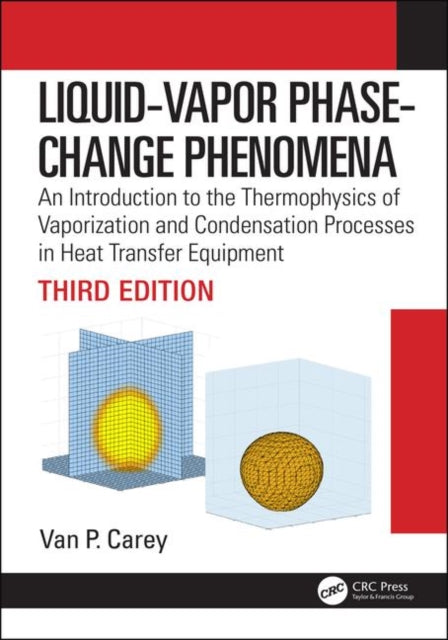Van P.Carey
Liquid-Vapor Phase-Change Phenomena: An Introduction to the Thermophysics of Vaporization and Condensation Processes in Heat Transfer Equipment, Third Edition
Liquid-Vapor Phase-Change Phenomena: An Introduction to the Thermophysics of Vaporization and Condensation Processes in Heat Transfer Equipment, Third Edition
YOU SAVE £5.76
- Condition: Brand new
- UK Delivery times: Usually arrives within 2 - 3 working days
- UK Shipping: Fee starts at £2.39. Subject to product weight & dimension
Bulk ordering. Want 15 or more copies? Get a personalised quote and bigger discounts. Learn more about bulk orders.
Couldn't load pickup availability
- More about Liquid-Vapor Phase-Change Phenomena: An Introduction to the Thermophysics of Vaporization and Condensation Processes in Heat Transfer Equipment, Third Edition
The third edition of "Liquid-Vapor Phase-Change Phenomena" has been updated to include new coverage of microchannels and nanostructures, as well as more worked examples and problems. It also includes a solution manual and electronic figures for classroom projection.
\n Format: Hardback
\n Length: 706 pages
\n Publication date: 11 March 2020
\n Publisher: Taylor & Francis Inc
\n
Since the second edition of Liquid-Vapor Phase-Change Phenomena was published, significant advancements have been made in our understanding of the impact of nanostructured surfaces, the effects of microchannel and nanochannel geometries, and the influence of extreme wetting on liquid-vapor phase-change processes. To encompass these developments, the third edition of this book has been extensively revised and updated. It now includes extensive coverage of microchannels and nanostructures, along with numerous other revisions. In addition, the book has been enriched with more worked examples and an abundance of new problems to challenge readers. Furthermore, a comprehensive solution manual and electronic figures for classroom projection will be made available to qualified adopting professors.
Nanostructured surfaces have gained significant attention in recent years due to their unique properties that can enhance the performance of various applications. These surfaces, which are characterized by their small size and hierarchical structure, possess a high surface area-to-volume ratio, which allows for increased interactions between the surface and the surrounding environment. One of the key advantages of nanostructured surfaces is their ability to control the wettability of liquids, which is crucial in many industrial processes such as drug delivery, energy storage, and catalysis. By tailoring the surface properties, such as surface chemistry, roughness, and topography, it is possible to manipulate the contact angle, surface energy, and capillary forces, thereby influencing the wetting behavior of liquids.
Microchannel and nanochannel geometries have also emerged as powerful tools for studying liquid-vapor phase-change processes. These structures, which are characterized by their narrow width and length, provide a controlled environment for the evaporation and condensation of liquids. By varying the dimensions and shape of the channels, it is possible to achieve different flow patterns, heat transfer rates, and mass transfer rates, which in turn affect the phase-change behavior. For example, microchannels with a narrow width can enhance the evaporation rate, while nanochannels with a small diameter can promote the nucleation and growth of droplets, leading to a more efficient phase-change process.
Extreme wetting, which refers to the ability of a liquid to wet a solid surface at temperatures and pressures far below its saturation point, has also been extensively studied in recent years. This phenomenon is of particular interest in many industrial applications, such as oil and gas extraction, where it can improve the efficiency of extraction processes. By understanding the mechanisms behind extreme wetting, it is possible to develop new materials and surfaces that can enhance the wettability of solids, thereby reducing the energy required for extraction.
In conclusion, the second edition of Liquid-Vapor Phase-Change Phenomena has played a crucial role in advancing our understanding of the effects of nanostructured surfaces, microchannel and nanochannel geometries, and extreme wetting on liquid-vapor phase-change processes. The third edition of this book further enhances our knowledge in these areas by providing comprehensive coverage of these topics and incorporating numerous updates and revisions. As research in these fields continues to progress, we can expect to see even more exciting developments and applications in the future.
\n Weight: 1448g\n
Dimension: 185 x 259 x 47 (mm)\n
ISBN-13: 9781498716611\n
Edition number: 3 New edition\n
This item can be found in:
UK and International shipping information
UK and International shipping information
UK Delivery and returns information:
- Delivery within 2 - 3 days when ordering in the UK.
- Shipping fee for UK customers from £2.39. Fully tracked shipping service available.
- Returns policy: Return within 30 days of receipt for full refund.
International deliveries:
Shulph Ink now ships to Australia, Belgium, Canada, France, Germany, Ireland, Italy, India, Luxembourg Saudi Arabia, Singapore, Spain, Netherlands, New Zealand, United Arab Emirates, United States of America.
- Delivery times: within 5 - 10 days for international orders.
- Shipping fee: charges vary for overseas orders. Only tracked services are available for most international orders. Some countries have untracked shipping options.
- Customs charges: If ordering to addresses outside the United Kingdom, you may or may not incur additional customs and duties fees during local delivery.


